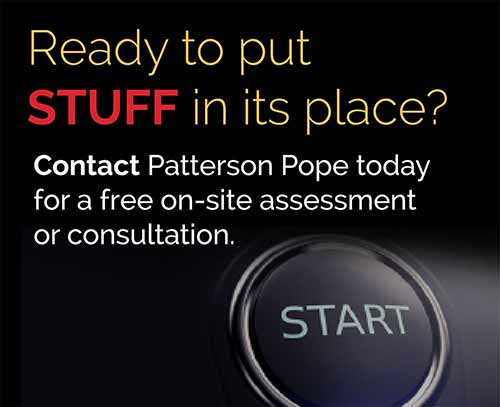Moving house is stressful. And there's more to relocating an office than just moving furniture and employees. It's an opportunity to optimize your storage and organization systems so you can support your business operations better, especially in modern, hybrid work environments.
Here's a comprehensive checklist of storage and organization needs, along with solutions to consider during your office relocation planning. Our focus is maximizing efficiency, security, and flexibility using a tailored blend of traditional. storage solutions and modern innovations.
Storage and Organization Needs Checklist
1. File and Document Storage
Need:- Safe and accessible storage for secure files and documents.
- Efficient use of space to accommodate physical records.
- Solutions to manage both frequently used and archived documents.

- High-Density Mobile Shelving: Maximizes floor space by eliminating fixed aisles and creating moveable aisles that can store twice as much in the same footprint.
- Compact Shelving: Provides efficient storage for boxed files and other document-heavy needs, reducing the required space.
- Rotary Cabinets: Double your storage capacity while minimizing the footprint. Ideal for tight spaces.
- Secure Compact Lateral File Storage: Provides organized, secure storage for files with easy access.
2. Personal and Shared Storage
Need:- Secure storage for employees' personal belongings.
- Organized storage for shared office supplies and equipment.

- Smart Lockers: Offer touchless, secure storage for personal items, mail, and packages. Ideal for hybrid work environments.
- Modular Lockers: Provide flexible storage options for personal and shared items that can be reconfigured as needs change.
- Day-Use Lockers: Temporary storage for employees who don't have a permanent desk.
- Bi-File Cabinets: Compact storage for shared supplies that maximizes space.
3. Equipment and IT Storage
Need:- Safe and organized storage for IT equipment and office machinery.
- Easy access for maintenance and quick supply retrieval.

- Modular Casework: Customizable storage units for IT equipment, ensuring all items are organized and easily accessible.
- Bulk Storage on Mobile Shelving: Efficient storage for larger IT components and office machinery.
- Smart Lockers for IT: Secure and track equipment repairs and exchanges with integrated software.
- 4-Post Shelving for Laptop Storage: Organized storage specifically designed for laptops and other small electronics.
- Cabinets and Shelving in IT Repair Center: Specialized storage solutions for repair and maintenance areas
4. Archival Storage
Need:- Long-term preservation of important documents and artifacts.
- Protection from environmental factors like temperature and humidity.
- Archival Storage Systems: Specialized storage that ensures the preservation of valuable and sensitive materials.
- Secure Compact Shelving: Lockable units that provide additional security for sensitive documents.
- Cantilever Library Shelving: Adjustable shelving ideal for storing books, binders, and archival materials.
- Mechanical-Assist Mobile Shelving: Offers high-density storage with easy access for heavy or large archival items.
5. Office Supplies and Common Areas
Need:- Organized storage for office supplies, product samples, and other shared resources.
- Efficient use of common areas like mailrooms and supply closets.

- Rotary Cabinets: Double your storage capacity while minimizing the footprint. Ideal for tight spaces.
- High-Density Mobile Shelving: Store supplies in a compact area, freeing up space for other uses.
- Modular Casework for Mail Rooms: Customizable solutions for sorting and distributing mail efficiently.
- Mail Sorting Units: Modular units designed to organize and distribute office mail efficiently.
6. Flexible Workspaces
Need:- Adaptable spaces that can be easily reconfigured to meet changing needs.
- Solutions that support hybrid work models and collaborative environments.

- Movable Walls: Create flexible office layouts that can be adjusted as needed.
- Modular Casework: Versatile storage that can be reconfigured to support different office setups.
- Smart Lockers: Facilitate hot-desking and shared workspaces by providing secure storage for personal items.
- Day-Use Lockers: Ideal for employees who need temporary storage in a shared or hybrid workspace.
7. Specialized Storage
Need:- Storage solutions for unique items like medical supplies, artwork, or heavy tools.
- Systems that can handle specific storage requirements and protect valuable assets.
- Industrial Rotomats: Ideal for storing heavy tools or equipment in a compact, organized manner.
- Custom Shelving Systems: Tailored solutions for storing artwork, medical supplies, or other specialized items.
- Heavy-Duty Shelving for Facilities Storage Areas: Provides robust storage for large or heavy items.
- Shelving with Drawers for Facility Tool Storage: Secure and organize tools and small parts efficiently.
Making the Most of Office Moves
Effective storage and organization are critical to a successful office relocation. By considering the various needs and implementing the appropriate solutions, you can optimize your new workspace for efficiency, security, and flexibility. Whether it's traditional high-density shelving or modern smart lockers, the right storage systems can transform your office environment.
Contact a Patterson Pope representative today for expert assistance with office relocation planning and choosing the best storage solutions. Our comprehensive approach ensures every aspect of your move is covered, making for a smooth and successful transition.
















